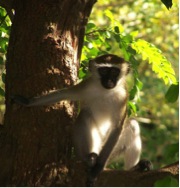This summer we launched our Africa Wildlife Cams in partnership with Mpala Research Centre in Lakipia, Central Kenya. The Cams are located in a section of the Ewaso Ng’iro River teeming with wildlife where more than 20 species have already shown up on the cams. We thought you should meet some of our African stars!
Animals of the Serengeti: Baboon
“There are five different species of baboons. [Four of the five live in African savannas.] Baboons are some of the world’s largest monkeys, and males of different species average from 33 to 82 pounds… Like other Old World monkeys, baboons do not have prehensile (gripping) tails. But they can and do climb trees to sleep, eat,
Thoughtful Monkey
Thoughtful Monkey Baboon actually. This year, The Atlantic compared similarities between these thoughtful animals and how Google’s search system works. “Google’s machine learning methods bear a familial resemblance to the baboon processing of language. After a mere six weeks of training, the baboons could tell an English word they’d never seen before (e.g. hope) from
Baboons and knit-picking is serious business.
Baboons and knit-picking is serious business. Did You Know? “During adulthood, dominance rank has different consequences for males and for females. For females, the effects of rank are subtle but pervasive. High ranking females can displace lower ranking females from food and water sources, can push them away and take their place in grooming episodes,
Monkey Monday?!
Monkey Monday?! Have you met Lesula? She’s a cousin of the African Baboons above. Lesula is the “discovered” (or uncovered) newest species of monkey in the Democratic Republic of Congo. Her unusually large, round eyes are reminiscent of the Lesula’s other cousins – us. Check out the Guardian’s article on the 10 new mammals discovered in



